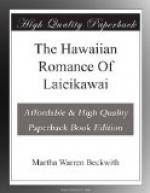[Footnote 27: The idiomatic passages “aohe puko momona o Kohala,” etc., and (on page 387) “e huna oukou i ko oukou mau maka i ke aouli” are of doubtful interpretation.]
[Footnote 28: This boast of downing an antagonist with a single blow is illustrated in the story of Kawelo. His adversary, Kahapaloa, has struck him down and is leaving him for dead. “Strike again, he may revive,” urge his supporters. Kahapaloa’s refusal is couched in these words:
“He is dead; for it is a blow from
the young,
The young must kill with a blow
Else will the fellow go down to
Milu
And say Kahapaloa struck frim twice,
Thus was the fighter slain.”
All Hawaiian stories of demigods emphasize the ease of achievement as a sign of divine rather than human capacity.]
CHAPTER V
[Footnote 29: Shaking hands was of foreign introduction and marks one of the several inconsistencies in Haleole’s local coloring, of which “the deeds of Venus” is the most glaring. He not only uses such foreign coined words as wati, “watch,” and mare, “marry,” but terms which are late Hawaiian, such as the triple canoe, pukolu, and provision boat, pelehu, said to have been introduced in the reign of Kamehameha I.]
[Footnote 30: Famous Hawaiian boxing teachers kept master strokes in reserve for the pupils, upon whose success depended their own reputation. These strokes were known by name. Compare Kawelo, who before setting out to recapture Kauai sends his wife to secure from his father-in-law the stroke called wahieloa. The phrase “Ka ai a ke kumu i ao oleia ia oukou” has been translated with a double-punning meaning, literal and figurative, according to the interpretation of the words. Cold-nose’s faith in his girdle parodies the far-fetched dependence upon name signs common to this punning race. The snapping of the end of his loin cloth is a good omen for the success of a stroke named “End-that-sounds”! Even his supporters jeer at him.]
[Footnote 31: Few similes are used in the story. This figure of the “blood of a lamb,” the “blow like the whiz of the wind,” the moo ploughing the earth with his jaw “like a shovel,” a picture of the surf rider—“foam rose on each side of his neck like a boar’s tusks,” and the appearance of the Sun god’s skin, “like a furnace where iron is melted,” will, perhaps, cover them all. In each the figure is exact, but ornamental, evidently used to heighten the effect. Images are occasionally elaborated with exact realization of the bodily sensation produced. The rainbow “trembling in the hot rays of the sun” is an example, and those passages which convey the lover’s sensations—“his heart fainted with love,” “thick pressed with thunders of love,” or such an image as “the burden of his mind was lifted.” Sometimes the image carries the comparison into another field, as in “the windings and twistings of his journey”—a habit of mind well illustrated in the occasional proverbs, and in the highly figurative songs.]




